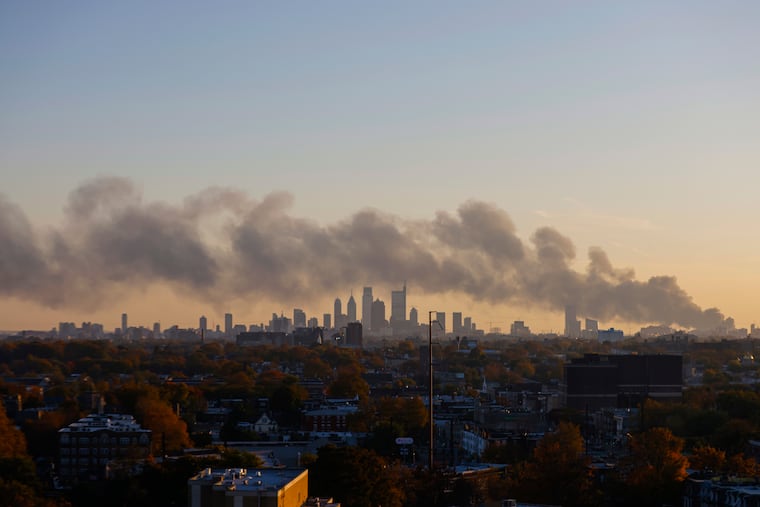What we know about the junkyard fire in Southwest Philly
The two-alarm fire started at Delaware Valley Recycling, Inc., at 3107 S. 61st St., around 3 p.m., sending billowing black smoke across the city that remained noticeable into Wednesday.

A fire blazed within a Southwest Philadelphia junkyard Tuesday afternoon, sending up black billows of smoke that could be seen for miles across the city, and causing lingering air quality effects on Wednesday. It took almost 100 firefighters over two hours to control the flames, which ignited numerous piles of tires and debris. No injuries were reported.
Questions remain on how the fire started, the company involved, and the health impacts associated with the burned materials. Here’s what we know so far:
When and where did the fire take place?
The two-alarm fire started at Delaware Valley Recycling, Inc., at 3107 S. 61st St., around 3 p.m. About 100 personnel from the Philadelphia Fire Department responded and got the blaze under control at 5:30 p.m.
The junkyard sits on the edge of Southwest Philadelphia on the Schuylkill River, between Lindbergh Boulevard and West Passyunk Avenue. Residential blocks and homes are less than half a mile down the street. The smell of burning rubber lingered in the air Wednesday afternoon, and light smoke emanated from the site.
What caught on fire, and what caused it?
At least six piles of tires and construction materials — some estimated to be six stories high — caught fire, said Philadelphia Fire Department Capt. Derek Bowmer.
The cause remains under investigation, but Phil Auld, an owner of Delaware Valley Recycling, said it’s possible a client dropped off materials that contained an accelerant.
Why was it so difficult to control?
“Tires burning, that rubber burning, is very hard to extinguish. Lots and lots of gallons of water have to be put onto it,” said Bowmer.
Bowmer said it was difficult for firefighters to access the area, and the department had to bring in two marine units off the Schuylkill River to help surround the flames from all angles.
“Just getting access to the area to put water or foam that we use inside was a challenge for us,” he said. “Normally how the companies pile everything, it’s a tough area, the fire is deep-seated inside these piles. It takes a while to get the water in there and soak it in.”
Firefighters remained at the site Wednesday afternoon to control any remaining “hot spots” of flames, he said.
What is Delaware Valley Recycling?
The business has been around since 1991, said Auld. Tuesday’s fire was the first incident of its kind since he became an owner about 10 years ago, he said.
The company acts as a middleman, taking truckloads of construction debris, metals, and millings and either recycles them or loads the materials in trailers that are sent to landfills hundreds of miles away, Auld said.
“We don’t burn anything here, we don’t have any odors here. It’s construction demolition debris, it’s inert material,” Auld said.
What are the health implications of the smoke?
Air Management Services within the Philadelphia Department of Health responded to the scene of the fire at 6:31 p.m. on Tuesday and collected air samples to test for toxins. Wednesday afternoon, the health department reported that “no toxic compounds were identified in that sample at levels that would threaten the public’s health,” said department spokesperson Jim Garrow.
The air sampling looked for toxic compounds that can cause cancer or present an immediate and toxic threat, Garrow said.
Some of those chemicals were identified in the sample, but “the compounds identified were all found at levels thousands to hundreds of thousands of times below where the EPA has identified as potentially causing long-term harm,” he said.
Garrow said the biggest risk to the public was higher than normal levels of PM 2.5, or fine particulate matter, which can “cause short-term health effects such as eye, nose, throat and lung irritation, coughing, sneezing, runny nose and shortness of breath,” according to the New York health department’s website. Longer-term exposure to fine particles can also affect lung function and worsen medical conditions such as asthma and heart disease.
Still, the U.S. Environmental Protection Agency says burning tires emit noxious fumes.
The Health Department recommends that people in areas of the city experiencing smoke or haze limit their time outside, and that people with heart and/or lung problems should try not to exert themselves or strain their bodies. “The smoke and haze should be lower during the day on Wednesday, but may increase during the evening and overnight due to weather conditions,” it said.